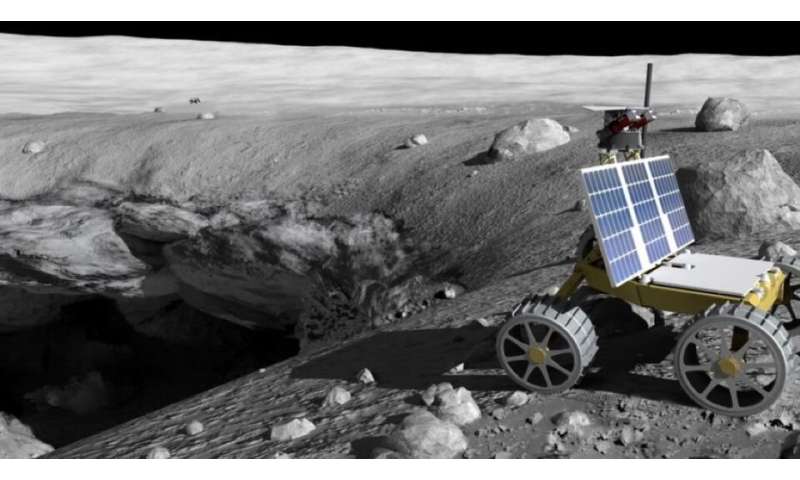NASA selects Carnegie Mellon to develop lunar pit exploration technology

NASA has approved a $2 million research initiative for Carnegie Mellon University roboticists to develop technologies necessary for robots to explore pits on the moon—the lunar equivalent of sinkholes—which might provide access to shelter and resources that could sustain future lunar missions.
William "Red" Whittaker, a professor in CMU's Robotics Institute, has proposed using one or more smart, speedy robots to explore and develop models of pits that have been discovered in orbital imagery, but never studied from the moon's surface.
"From orbit, you can't get the viewpoints or proximity to see the details that matter," Whittaker said. "That's why we need robots. Is there a way in? Are there overhangs? Could a robot rappel in? Might there be a fissure, cavern or cave opening?"
Unlike craters, which are created when asteroids or meteorites strike the moon, pits form when the surface collapses into a hollow underground void. Whittaker said pits could expose caverns that might be used by future explorers and could provide access to minerals, ice and other resources.
This latest two-year funding is from the NASA Innovative Advanced Concepts (NIAC) program, which funds visionary "high risk/high payoff" ideas. It will enable Whittaker and his colleagues, including partners from the NASA Ames Research Center and Astrobotic, to further develop the technologies and methods necessary for the mission—maturing the technologies to the point where they could be implemented. This so-called Phase III funding is the first ever awarded by the NIAC program.
"We are pursuing new technologies across our development portfolio that could help make deep space exploration more Earth-independent by utilizing resources on the moon and beyond," said Jim Reuter, associate administrator of NASA's Space Technology Mission Directorate. In addition to Whittaker's proposal, funding also was awarded to an asteroid mining concept by TransAstra Corp. "These NIAC Phase III selections are a component of that forward-looking research, and we hope new insights will help us achieve more firsts in space."
Additional funding will be necessary to complete preliminary and final design. A robotic mission that will deploy the resulting technology can't occur until perhaps 2023. Such a capability would be far beyond that recently announced by Carnegie Mellon for sending a toaster-size robot developed by Whittaker to the moon in 2021.
A pit mission envisioned by Whittaker, called Skylight, would require one or more robots to complete their observations within a week, before they are enveloped by the deep cold of a lunar night that would permanently disable them. He expects the robots would be delivered to the moon by a lander such as the Peregrine lander developed by Pittsburgh's Astrobotic.
Completing a Skylight mission quickly will require speedy robots that can travel miles and gather thousands of images. Because of the communication limitations of the rovers, they will need to return periodically to the vicinity of the lander to download images, then resume exploration.
"Beyond possessing the autonomous means to explore, the rovers need to know when and how to come home," Whittaker said.
The robots also will require a capability Whittaker calls "exploration autonomy," which will allow them to make their own judgments about where they need to go to gather the information needed and about how close they dare get to the rim of the pit. There simply isn't time for "step, stop, mother-may-I" decision making by operators on Earth, he said.
Another capability to be developed with the new funding is a modeling engine for computing on board the lander. Whittaker said the computer will need to extract information from the thousands of images collected by the rovers to build a high-fidelity, high-resolution, scientifically valid computer model of the pit, which could then be transmitted back to Earth.
Provided by Carnegie Mellon University